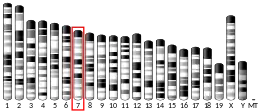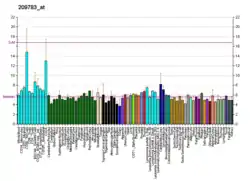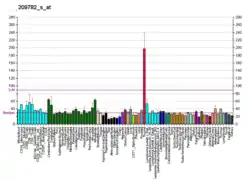| DBP | |||||||||||||||||||||||||||||||||||||||||||||||||||
|---|---|---|---|---|---|---|---|---|---|---|---|---|---|---|---|---|---|---|---|---|---|---|---|---|---|---|---|---|---|---|---|---|---|---|---|---|---|---|---|---|---|---|---|---|---|---|---|---|---|---|---|
| Identifiers | |||||||||||||||||||||||||||||||||||||||||||||||||||
| Aliases | DBP, DABP, D-box binding PAR bZIP transcription factor, taxREB302 | ||||||||||||||||||||||||||||||||||||||||||||||||||
| External IDs | OMIM: 124097 MGI: 94866 HomoloGene: 1035 GeneCards: DBP | ||||||||||||||||||||||||||||||||||||||||||||||||||
| |||||||||||||||||||||||||||||||||||||||||||||||||||
| |||||||||||||||||||||||||||||||||||||||||||||||||||
| |||||||||||||||||||||||||||||||||||||||||||||||||||
| |||||||||||||||||||||||||||||||||||||||||||||||||||
| Wikidata | |||||||||||||||||||||||||||||||||||||||||||||||||||
| |||||||||||||||||||||||||||||||||||||||||||||||||||
D site of albumin promoter (albumin D-box) binding protein, also known as DBP, is a protein which in humans is encoded by the DBP gene.[5][6]
DBP is a member of the PAR bZIP (Proline and Acidic amino acid-Rich basic leucine ZIPper) transcription factor family.[5][7] DBP binds to an upstream promoter in the insulin gene.[8]
References
- 1 2 3 GRCh38: Ensembl release 89: ENSG00000105516 - Ensembl, May 2017
- 1 2 3 GRCm38: Ensembl release 89: ENSMUSG00000059824 - Ensembl, May 2017
- ↑ "Human PubMed Reference:". National Center for Biotechnology Information, U.S. National Library of Medicine.
- ↑ "Mouse PubMed Reference:". National Center for Biotechnology Information, U.S. National Library of Medicine.
- 1 2 "Entrez Gene: DBP D site of albumin promoter (albumin D-box) binding protein".
- ↑ Szpirer C, Riviere M, Cortese R, Nakamura T, Islam MQ, Levan G, Szpirer J (Jun 1992). "Chromosomal localization in man and rat of the genes encoding the liver-enriched transcription factors C/EBP, DBP, and HNF1/LFB-1 (CEBP, DBP, and transcription factor 1, TCF1, respectively) and of the hepatocyte growth factor/scatter factor gene (HGF)". Genomics. 13 (2): 293–300. doi:10.1016/0888-7543(92)90245-N. PMID 1535333.
- ↑ Khatib ZA, Inaba T, Valentine M, Look AT (Sep 1994). "Chromosomal localization and cDNA cloning of the human DBP and TEF genes". Genomics. 23 (2): 344–51. doi:10.1006/geno.1994.1510. PMID 7835883.
- ↑ Melloul D, Marshak S, Cerasi E (Mar 2002). "Regulation of insulin gene transcription". Diabetologia. 45 (3): 309–26. doi:10.1007/s00125-001-0728-y. PMID 11914736.
Further reading
- Brown SA, Schibler U (Oct 1999). "The ins and outs of circadian timekeeping". Current Opinion in Genetics & Development. 9 (5): 588–94. doi:10.1016/S0959-437X(99)00009-X. PMID 10508692.
- Szpirer C, Riviere M, Cortese R, Nakamura T, Islam MQ, Levan G, Szpirer J (Jun 1992). "Chromosomal localization in man and rat of the genes encoding the liver-enriched transcription factors C/EBP, DBP, and HNF1/LFB-1 (CEBP, DBP, and transcription factor 1, TCF1, respectively) and of the hepatocyte growth factor/scatter factor gene (HGF)". Genomics. 13 (2): 293–300. doi:10.1016/0888-7543(92)90245-N. PMID 1535333.
- Khatib ZA, Inaba T, Valentine M, Look AT (Sep 1994). "Chromosomal localization and cDNA cloning of the human DBP and TEF genes". Genomics. 23 (2): 344–51. doi:10.1006/geno.1994.1510. PMID 7835883.
- Nyunoya H, Morita T, Sato T, Honma S, Tsujimoto A, Shimotohno K (Oct 1994). "Cloning of a cDNA encoding a DNA-binding protein TAXREB302 that is specific for the tax-responsive enhancer of HTLV-I". Gene. 148 (2): 371–3. doi:10.1016/0378-1119(94)90716-1. PMID 7958972.
- Nyunoya H, Morita T, Sato T, Honma S, Tsujimoto A, Shimotohno K (Apr 1993). "Cloning of a cDNA encoding a DNA-binding protein TAXREB302 that is specific for the tax-responsive enhancer of HTLV-I". Gene. 126 (2): 251–5. doi:10.1016/0378-1119(93)90375-D. PMID 8482542.
- Picketts DJ, Lillicrap DP, Mueller CR (Feb 1993). "Synergy between transcription factors DBP and C/EBP compensates for a haemophilia B Leyden factor IX mutation". Nature Genetics. 3 (2): 175–9. doi:10.1038/ng0293-175. PMID 8499951. S2CID 6392603.
- Andersson B, Wentland MA, Ricafrente JY, Liu W, Gibbs RA (Apr 1996). "A "double adaptor" method for improved shotgun library construction". Analytical Biochemistry. 236 (1): 107–13. doi:10.1006/abio.1996.0138. PMID 8619474.
- Shutler G, Glassco T, Kang X, Korneluk R, Mueller CR (Jun 1996). "Genomic structure of the human D-site binding protein (DBP) gene". Genomics. 34 (3): 334–9. doi:10.1006/geno.1996.0295. PMID 8786133.
- Stubbs L, Carver E, Ashworth L, Lopez-Molina L (Jan 1996). "Location of the DBP transcription factor gene in human and mouse". Mammalian Genome. 7 (1): 65–7. doi:10.1007/s003359900016. PMID 8903733. S2CID 40284548.
- Yu W, Andersson B, Worley KC, Muzny DM, Ding Y, Liu W, Ricafrente JY, Wentland MA, Lennon G, Gibbs RA (Apr 1997). "Large-scale concatenation cDNA sequencing". Genome Research. 7 (4): 353–8. doi:10.1101/gr.7.4.353. PMC 139146. PMID 9110174.
- Begbie M, Mueller C, Lillicrap D (Feb 1999). "Enhanced binding of HLF/DBP heterodimers represents one mechanism of PAR protein transactivation of the factor VIII and factor IX genes". DNA and Cell Biology. 18 (2): 165–73. doi:10.1089/104454999315556. PMID 10073576.
- Lamprecht C, Mueller CR (Jun 1999). "D-site binding protein transactivation requires the proline- and acid-rich domain and involves the coactivator p300". The Journal of Biological Chemistry. 274 (25): 17643–8. doi:10.1074/jbc.274.25.17643. PMID 10364202.
- Yan L, Miyake S, Okamura H (Jan 2000). "Distribution and circadian expression of dbp in SCN and extra-SCN areas in the mouse brain". Journal of Neuroscience Research. 59 (2): 291–5. doi:10.1002/(SICI)1097-4547(20000115)59:2<291::AID-JNR16>3.0.CO;2-O. PMID 10650888. S2CID 2684952.
- Smith JS, Tachibana I, Pohl U, Lee HK, Thanarajasingam U, Portier BP, Ueki K, Ramaswamy S, Billings SJ, Mohrenweiser HW, Louis DN, Jenkins RB (Feb 2000). "A transcript map of the chromosome 19q-arm glioma tumor suppressor region". Genomics. 64 (1): 44–50. doi:10.1006/geno.1999.6101. PMID 10708517.
- Newman JR, Keating AE (Jun 2003). "Comprehensive identification of human bZIP interactions with coiled-coil arrays". Science. 300 (5628): 2097–101. Bibcode:2003Sci...300.2097N. doi:10.1126/science.1084648. PMID 12805554. S2CID 36715183.
External links
- DBP+protein,+human at the U.S. National Library of Medicine Medical Subject Headings (MeSH)
This article incorporates text from the United States National Library of Medicine, which is in the public domain.
This article is issued from Wikipedia. The text is licensed under Creative Commons - Attribution - Sharealike. Additional terms may apply for the media files.





